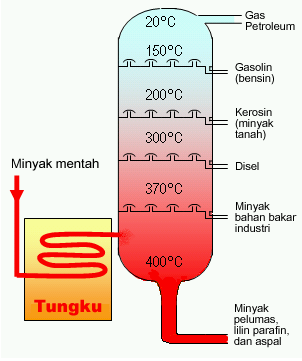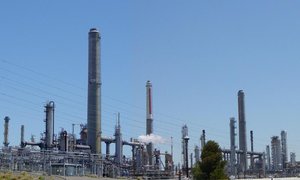Oil refinery
|
|
An oil refinery is an industrial process plant where crude oil is processed and refined into useful petroleum products.
Raw oil or unprocessed ("crude") oil is not very useful in the form it comes in out of the ground. It needs to be broken down into parts and refined before use in a solid material such as plastics and foams, or as petroleum fossil fuels as in the case of automobile and airplane engines.
Oil can be used in so many various ways because it contains hydrocarbons of varying lengths such as paraffins, aromatics, naphthenes (or cycloalkanes), alkenes, dienes, and alkynes.

Hydrocarbons are molecules of varying length and complexity made of hydrogen and carbon. Their various structures give them their differing properties and thereby uses. The trick in the oil refinement process is separating and purifying these. All these different hydrocarbons have different boiling points, which means they can be separated by distillation.
Once separated and any contaminants and impurities have been removed, the oil can be either sold without any further processing, or smaller molecules such as isobutane and propylene or butylenes can be recombined to meet specific octane requirements by processes such as alkylation or less commonly, dimerization. Octane can also be improved by catalytic reforming, which strips hydrogen out of hydrocarbons to produce aromatics, which have much higher octane ratings. Intermediate products such as gasoils can even be reprocessed to break a heavy, long-chained oil into a lighter short-chained one, by various forms of cracking such as Fluid Catalytic Cracking, Thermal Cracking, and Hydrocracking. The final step in gasoline production is the blending of fuels with different octane ratings, vapor pressures and other properties to meet product specifications.
MiRO1.jpg
Oil refineries can become very large and sprawling complexes with vast numbers of pipes running all throughout the facility. The refining process can cause many different chemicals to be released into the atmosphere - consequently a notable odor may accompany the presence of a refinery. Environmental groups have lobbied many governments to increase restrictions on how much material refineries can release, and many refineries have installed equipment and changed practices to lessen the environmental impact. In the United States, there is strong pressure to prevent the development of new refineries, and none have been built in the country for more than three decades. However, many already-existing refineries have expanded during that time. Both environmental and safety concerns mean that oil refineries are usually located a safe distance away from major urban areas. Nevertheless, there are potentially dangerous exceptions to this rule, a particularly notable one being the Santa Cruz refinery 1 (http://www.atan.org/en/refineria/vertidos/elcolmo.htm) (Tenerife, Spain), which is sited in a densely-populated city center and next to the only two major evacuation routes in and out of the city.
Common Units Found in a Refinery
- Atmospheric Distillation Unit (distills crude oil into fractions)
- Vacuum Distillation Unit (further distills residual bottoms after atmospheric distillation)
- Naphtha Hydrotreater Unit (desulfurizes naphtha from atmospheric distillation)
- Catalytic Reformer Unit
- Distillate Hydrotreater Unit (desulfurizes distillate (diesel) after atmospheric distillation)
- Fluid Catalytic Converter Unit
- Dimerization Unit
- Isomerization Unit
Trivia
The largest oil refinery in the world is in Ras Tanura, Saudi Arabia, owned by Saudi Aramco. The city was originally built as a sea port, but actually developed because of the huge refinery area. For most of the 20th century the largest refinery of the world was that of Abadan in Iran.
The world's first oil refinery opened at Ploiesti, Romania in 1856 [1] (http://www.pbs.org/eakins/we_1844.htm). Several other refineries were built at that location with investment from U.S. companies before being taken over by Nazi Germany during World War II. Most of these refineries were bombarded by the US Air Force in Operation Tidal Wave, August 1, 1943.
External links
- Discover Petroleum (http://www.schoolscience.co.uk/content/4/chemistry/petroleum/knowl/4/2index.htm?refinery.html), an educational site from the UK
- Short introduction to oil refining in a slideshow (http://catalysis.che.wsu.edu/~aplaton/interests/1_intro_to_oil_refining/)de:Erdölraffinerie

